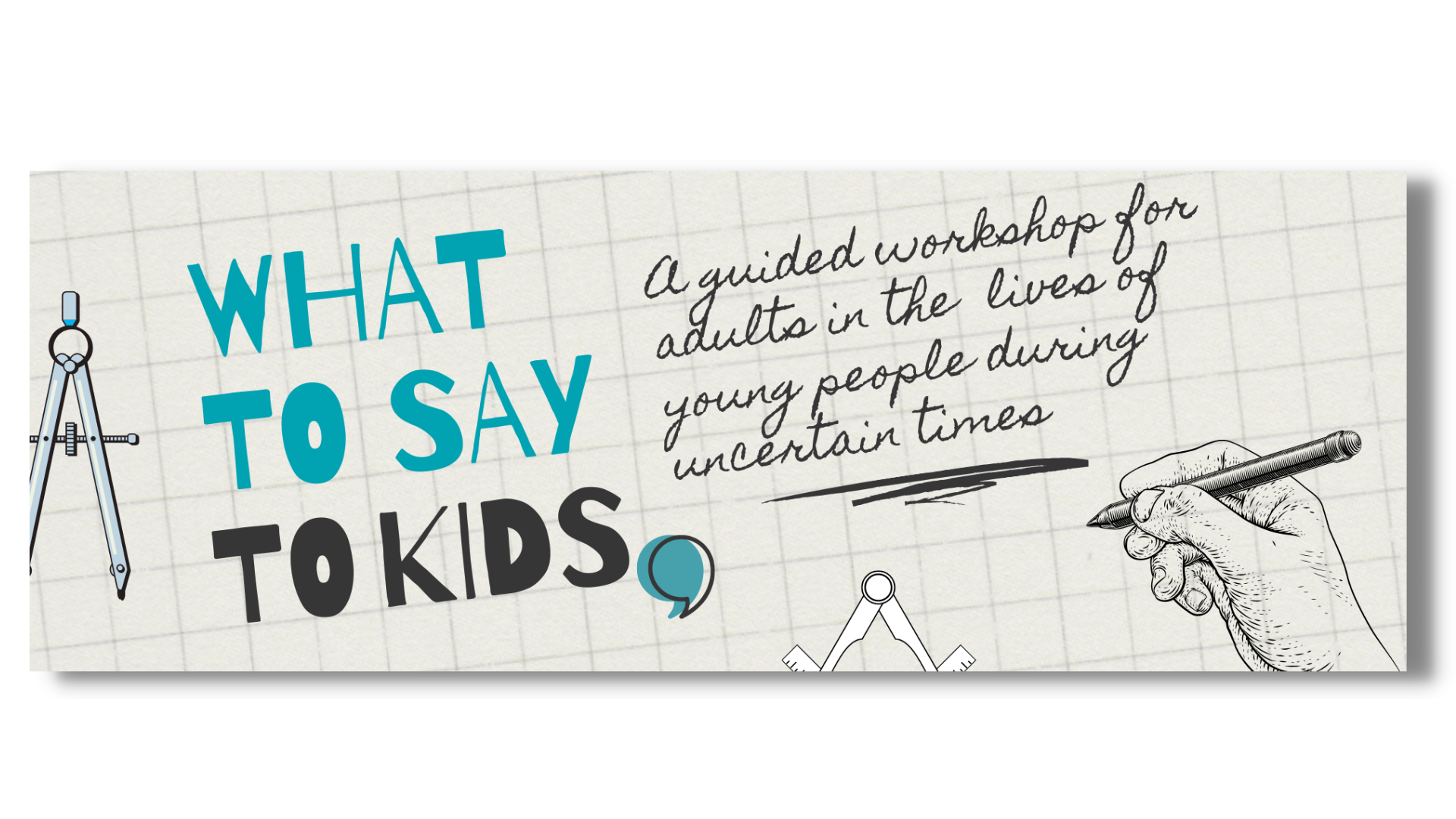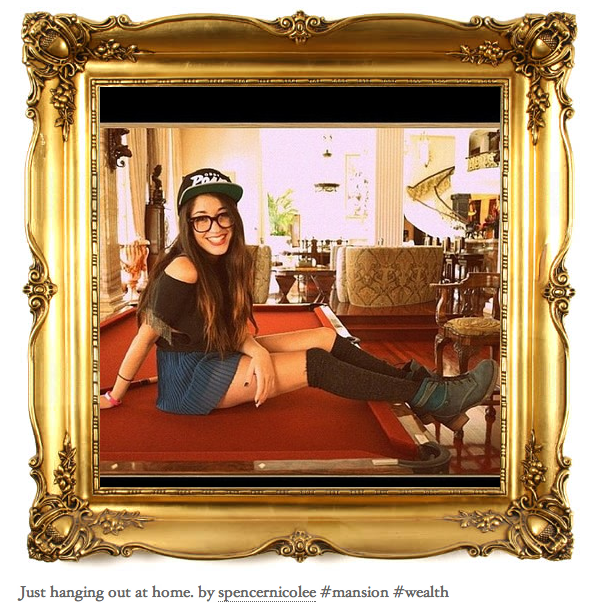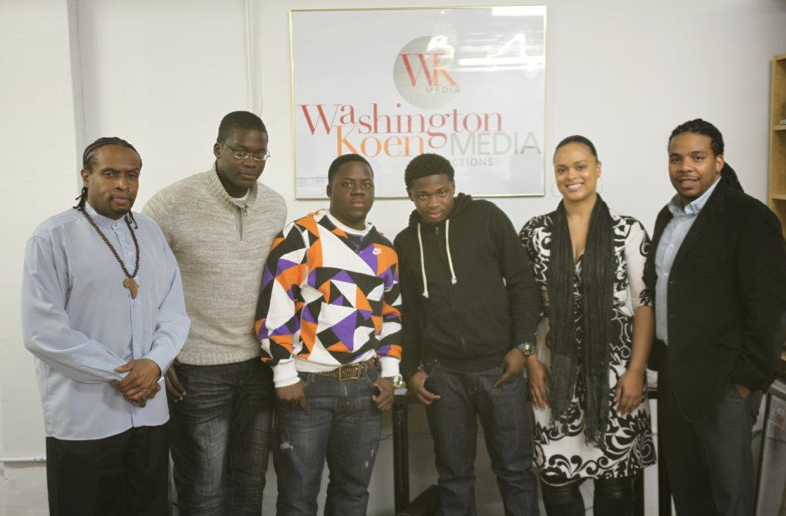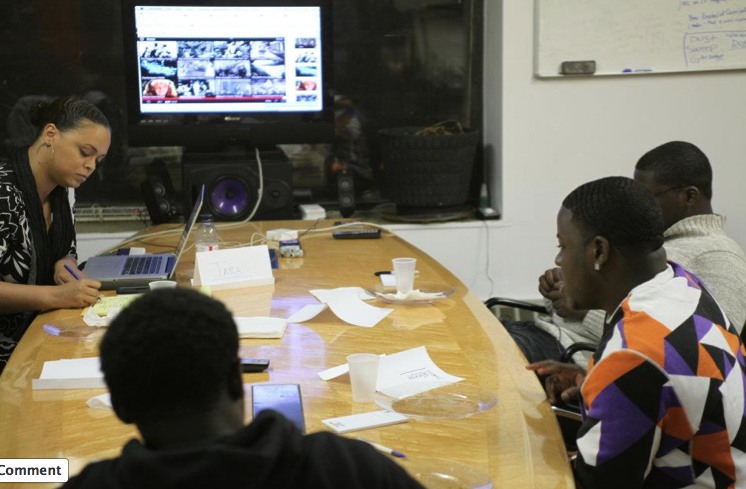What To Say To Kids Resources (2022)
Welcome!
Thanks for visiting and participating in What To Say To Kids: A Guided Workshop for Adults in the Lives of Young People During Uncertain Times (whew, that’s mouthful!). Below are references from the presentation, along with resources, handouts, and activities. To access the PDF handouts and activities, please use the special code provided during the presentation.
WTSTK Newsletter Coming October 2022!
Good news! I’m launching a What To Say To Kids (WTSTK) newsletter in October that will include more research, tips, and suggestions to help adults support young people as they navigate their mediated lives. Sign up here:
WTSTK Resources
Media Tools
How To Make a Family Media Use Plan (from the American Academy of Pediatrics).
Media Literacy and Critical Thinking Online (U.S. Department of Homeland Security): [PDF]
Mobile Apps. Here are some mobile apps that have been mentioned in research studies I reviewed for this presentation. I’m sharing these with you in the spirit of providing technology as support, rather than as surveillance of our young people. . Note: Some apps have been discontinued like Cerburus, which shut down a few years ago for violating terms of service. Keep this in mind as you reference these mobile apps: Technologies are not neutral, nor are they a substitution for meaningful connections with our young people. https://www.tomsguide.com/us/best-parental-control-apps,review-2258.html
NBC Nightly News For Kids: https://www.nbcnews.com/nightlykids
The Trevor Project (24/7 crisis support services for LGBTQIA youth): https://www.thetrevorproject.org
Today Explained, to Kids: https://www.vox.com/today-explained-to-kids
YouTube Kids: https://www.youtubekids.com
WTSTK Handouts and Activities
To access PDFs, click here and use the special code provided during the presentation.
Write a Personal Letter to a Young Person
Tips for Adults Supporting Kids Consuming Scary News
FAQs
Proactive Guide to Foster Connection, Support, and Critical Literacy
References
Below includes a list of research and reporting cited in the presentation.
Academic and Government Publications
Auxier, B., Anderson, M., Perrin, A. and Turner, E. (July 28, 2020). Parenting in the age of screens. Pew Internet Research report. Retrieved from https://www.pewresearch.org/internet/2020/07/28/parenting-children-in-the-age-of-screens/
Ebbinkhuijsen, M., Bevelander, K.E., Buijzen, M., and Kleemans, M. (2021).“Children’s emotions after exposure to news: Investigating chat conversations with peers as a coping strategy,” Journal of Youth and Adolescence, 50: 1424-1436.
Edgerly, S., Thorson, K., and Bode, L. (2018). “Do parents still model news consumption? Socializing news use among adolescents in a multi-device world,” ( New Media & Society, 20(4): 1263–1281.
Gennaro, S. and Miller, B. (2021). Young people and social media: Contemporary children’s digital culture. Vernon Art and Science Inc.
Madden, M. Lenhart, A, and Fontaine, C. (March 1, 2017). How youth navigate the news landscape. Data & Society report. Retrieved from https://datasociety.net/library/how-youth-navigate-the-news-landscape/ [PDF].
News and Trade Publications
An Out Teen in the ‘Don’t Say Gay’ State (September 2022). What Next Podcast.
Don’t Teach Your Kids to Fear the World by Arthur C. Brooks (September 2022). The Atlantic.
Inside the Adolescent Mental Health Crisis (August, 2022). The Daily Podcast.
Social Media Wellness: Helping Tweens and Teens Thrive in an Unbalanced Digital World by Ana Homayoun (2017).
Teens in Distress are Swamping Pediatricians by Matt Richter (May 2022). The New York Times.
The Chaos That Made YouTube a Juggernaut (September 2022). What Next TBD Podcast.
The DeSantis Ally on the School Board (September 2022). What Next Podcast.
The Need to Educate the Rich Kids of Instagram
From My MEDIAted Life
There is a new Tumblr page that has been getting quite a bit of attention in the last few weeks. It's got an unoriginal, yet strangely catchy title that would cause almost anyone to click on the link: Rich Kids of Instagram. Your finger might hover over the mousepad for a moment--sure that it could not possibly be what the straight-forward label is seeming to describe, yet weary that it most likely is--you wonder if this is what you should be doing with your time? Should you throw a load of laundry in before you make this time commitment for something you might later regret, or worse, that you might absolutely love (but not be able to tell anybody about)? But like so many other viral videos and Internet memes, in which a mere click stands between you andknowing what everyone else is talking about, this site wins over any rational thought, and just like that you feel the pad of your index finger make contact with the cool sensory surface beneath it.
As soon as the URL loads and the site opens, you dive face-first into a scrolling cluster of photographs and hashtags. The images have all presumably been taken by smartphones (most likely iPhones) and have been enhanced through an application called Instagram, which adds different filters to digital pictures and allows them to be uploaded to various social networking platforms (i.e., Facebook, Twitter, Tumblr, etc.) instantly and seamlessly. The subtitle of the site is "They have more than you and this is what they do," and the hashtag is #rkoi. The images are first uploaded by the young people who snapped the shots to the RKOI's Twitter account and are then fed onto the Tumblr page for easy viewing.
The pictures are displayed in gold frames, suggesting that they are pieces of fine art and conveying an obvious and assumed air of wealth, high culture, and importance. Below each image we find numerous hashtags that the artists have used to 'describe' their masterpieces: #mansion, #wealth, #yacht, #personalchef, #cartier, #NBD (no big deal). The seemingly endless collection of photographs are obnoxious, yet every time I visit the site I find myself clicking from page to page, thirsty for more, even if I've seen the same images four or fives times at this point. What is going on?!As hard as I try to maintain that I am fascinated by this warped website solely for critically analytical and research-related purposes (I'm making a very serious face while saying this), the reality is that I have been 'trained'--socialized and normalized--for decades now to associate the types of images and messages depicted on this site with notions of what "happiness", "success", "popularity", etc. look like; what they mean. If I am having these reactions as a 28-year-old, we must seriously consider how teens might be viewing this site and think about the kinds of conversations that we as educators, adults, parents, can have with the young adults in our lives.
1. The subtle effects and implications of the gold-frame template:
While viewers might feel as if they've become numb to composition after streaming through dozens of images, there is an undeniable novelty and uniqueness in seeing photographs, not oil paintings, housed in these garish golden frames. Instead of invoking a simulated feeling that we are strolling through the quiet rooms of art gallery or museum--observing these masterpieces interspersed on stark white walls--the juxtaposition of the bold, saturated, filtered photographs with the chunky golden frames instead creates a feeling of voyeurism among viewers. We are outsiders being granted access to certain snapshots, postage-stamp views, of what life in the 1% is like.
What might this voyeurism mean for both the creators and consumers of these images? There is an extreme sense of excitement on both ends: for the creators of these media images and messages--they are sharing their lived experiences and material possessions with their peers (and now with wider audiences). Hell, at 14-, 17-, even at 25-years-old (especially in the age of social media and social networking sites), there is a certain undeniable, almost unavoidable [I said almost] narcissism that runs rampant in users' status updates, photos, etc. It's the nature of the beast, but it doesn't make it ok, or mean that we simply and passively accept that this is just how people can and should act as a result. We still must consider, now more than ever, what effects these displays of wealth, materialism, lifestyle and activities might have on the "99%" who have been socialized to perhaps think this representation is 'covetable', on the "1%" who think this representation is "normal." And what it really comes down to is that we should really be taking into account the possible effects that these representations are having on100% of today's youth. Virtually almost (again, almost) every young person in the US is exposed to and interacts with some sort of media on a daily basis--using a cell phone, playing a video game, surfing the Web, or watching television. Today's youth are growing up in an increasingly media-saturated culture and we have a responsibility to help them learn how to successfully navigate their lives through the unprecedented products, behaviors, and activities now being "the norm" in the 21st century.
2. Understanding digital footprints & increasing awareness about digital citizenship:
On August 10, 2012, an article was published on the Bloomberg Businessweek website entitled, "The Very Real Perils of Rich Kids on Social Networks". The article provides an account of how some recent online activities of Alexa and Zachary Dell, daughter and son of Michael Dell (of Dell computers), got them their 15 minutes of Internet fame as well as a terminated Twitter account after Alexa posted a photo of her brother in their private jet, heading to Fiji on RKOI. It was later discovered that this was just one of numerous photographs and statuses containing personal information about her family's whereabouts and activities that she'd posted over the last few months. Mr. Dell pays almost $3 million a year for security protection of his family, so needless to say, this breach of security from an insider was probably both alarming and upsetting. This article provides a powerful illustration and example not only of how quickly information spreads via new media platforms like Twitter and Facebook, but more importantly how easily this information can directly challenge others' efforts of enforcing tangible security measures. In addition, and most importantly, this article serves as an excellent example of the lack of awareness and/or regard that young people tend to have for the often permanent digital footprints that they create as a result of their online activities, particularly on social networking sites. And while some may argue that there are greater implications when the rich (and not necessarily famous) upload pictures of everything from party invitations with the date, time, and location to license plate numbers (all of which can easily and automatically be geo-tagged) to the Twittersphere, the reality is that this online behavior/activity of constantly over-sharing details about their lives can have very real consequences, regardless of one's social class. In a recent New York Times article on the recent upsurge of 20-somethings sharing TMI (too much information) in the workplace, Peggy Klaus, an author and executive coach of corporate training programs explains,
Social media have made it the norm to tell everybody everything...MANY people blame narcissistic baby-boomer parents for raising children with an overblown sense of worth, who believe that everything they say or think should be shared. When I told a British colleague that many Americans were starting to realize that they reveal way too much about themselves, he gave a full-throated laugh and said, “Finally!”
While our first instinct may be to want to protect youth, the takeaway here is not that we need to shield young people from the media tools and content that might cause them to engage in risky activities and behaviors. Instead, we should regard the situation with the Dell children and the realities of the millennial generation outlined by Klaus as important illustrative examples of the fast-forward-moving trajectory that our society and culture is travelling on. As educators, parents, and adults in the 21st century, we have an opportunity and obligation to use these examples to engage the youth in our lives in conversations about digital citizenship, which can include topics of online safety and privacy, cyberbullying, and copyright fair use of online information; media literacy, understanding how and why media messages are constructed and how they can influence beliefs and behaviors; and digital literacy, how to read and evaluate information online.
Use the images on RKOI to ask youth about who they think the image is intended for, what attracts their attention, what lifestyles and behaviors are represented, how different people might interpret the images and messages differently, and what they think may have been left out of the image and why? A conversation about the composition of both the photographs and the website itself—having students think critically about representation, communication, and production—could be integrated into an English lesson on writing about and showing one’s lived experiences through words and images; a social studies lesson on the powerful images and messages from the Civil Rights Movement, juxtaposing them with the very different content displayed on RKOI (in which case, it would also be crucial and a unique way to address issues of race, gender, and class as they relate to both sets of images and messages); or a computers and technology lesson focusing on the dos and don’ts of web-design.
The bottom line is that we must have conversations, many multi-layered conversations, with each other and with youth about sites like RKOI: about the activities and lifestyles represented, as well as the online and offline behaviors fueling the creation of and participation in such sites. It is ok and very normal to want to protect our youth from the unknown, but we’re doing ourselves and them a disservice if we think that leaving these unprecedented realities unaddressed is better than sinking our teeth into them in order to proactively figure all of this out, and we need to do it together--parents and children, teachers and students, peers to peers, or else we're never going to get anywhere.
Emily Bailin is a doctoral student at Teachers College, Columbia University. She's also an an educator, consultant, and public speaker motivated by a passion and determination to collaborate, create, and sustain culturally relevant and socially just pedagogy with other educators to better serve increasingly diverse 21st century learners. You can follow her on Twitter at @emilybailin
An Educator's Guide to Pinterest [Media Literacy]
The National Association of Media Literacy Education defines media literacy as "a series of communication competencies, including the ability to access, analyze, and communicate information in a variety of forms, including print and non-print messages."
More specifically, NAMLE breaks down media literacy into several definitions:
- Media refers to all electronic or digital means and print or artistic visuals used to transmit messages.
- Literacy is the ability to encode and decode symbols and to synthesize and analyze messages.
- Media literacy is the ability to encode and decode the symbols transmitted via media and the ability to synthesize, analyze and produce mediated messages.
- Media education is the study of media, including ‘hands on’ experiences and media production.
- Media literacy education is the educational field dedicated to teaching the skills associated with media literacy.
Last week, the Wall Street Journal reported that the newest darling of social networks, Pinterest, is valued at over $1 billion. As the online pinboard platform grows in influence, media literacy educators may want to consider ways in which the platform can be used to incite conversations about representation on the web.
Below are some ideas for using Pinterest in various formal and informal learning settings. These general activities are grouped according to some of the main components of media literacy education outlined by NAMLE above, including; Decoding, Encoding, and Communicating Messages, and Media Production. Please feel free to share and expand on these ideas in the comment section below.
Decoding, Encoding, and Communicating Messages
Questions: Who/what is source of the message? How is the media message conveyed through Pinterest? By whom is the message received? How might the source information and platform itself impact how the message is received?
- Students can begin by creating pinboards that represent social, community, and political issues they care about most. Make use of the search function within Pinterest (not only the categories section) to explore topics of interest.
- Students can create 'counter pinboards' in response to controversial posters as a way to incite discussions within the platform and extend conversations offline.
- Debate! Use comment sections to debate content on Pinterest (see Kate Moss 'Skinny' poster).
- Cross curate with other social media platforms (Facebook, Twitter, & alternative SMS and personal blogs). Post, tweet, embed images and videos from Pinterest to incite further discussions about how media messages are represented on the web.
- Organize "Media Lit Pint-Ups" or Pinterest meet ups, to showcase, discuss, and debate content popularized by way of Pinterest.
- Organize Pinterest scavenger hunts with media literacy education principals in mind. For instance, incorporate Google Maps to also explore how (and in what ways) users curate using geographical spaces. See Google Maps images on Pinterest.
- 'Fundraise for a cause' using Pinterest. Create original pinboard content having to do with an issue for which you wish to raise money. Include donation information in the caption section of the images.
Media Production
Questions: What can I create to make Pinterest better? What can I produce beyond the confines of Pinterest's platform ? What tools can I use to produce media influenced by content found on Pinterest and/or influenced by the platform itself? How might the design of my media influence the message I am trying to convey?
- Design a 'copy cat' Pinterest platform with a specific aim to interrogate/investigate media representations in online spaces.
- Storytelling with images: Create boards that tell alternative stories. Involve commenters to help create narratives.
- Produce, publish, and compose other types of online media (digital video, wikis, blogs) inspired by content found on Pinterest
- Create and curate "Media Lit" content in the DIY and Education categories on Pinterest. Create "Media Lit" pinboards as resource pages.
See also:
Community Producers Program is Thriving!
A few months ago Media Make Change partnered with the Beyond the Bricks Project to create a comprehensive media literacy program that serves young Black males. The Community Producers Program is a four-month course that invites young Black males to interrogate media images and subsequently create their own stories using digital media technology. We're elated to report that the program, now in it's second month, is thriving. Take a look at the new campaign video featuring several young men currently enrolled in the program at Teachers College, Columbia University--a sponsoring university.
We encourage you to donate to the summer fellowship program, an extension of the Community Producers Program, so the young men can continue to produce awe-inspiring work. If you are unable to donate, then please consider spreading the word to your various networks and encourage family, friends, and co-workers to contribute to this project.
On behalf of Media Make Change, I want to thank all of those involved in creating this program from the ground up, including Derek Koen, Ouida Washington, Dana Salter, Nisaa Ali, Bianca Baldridge, and Jose Vilson. I'm overjoyed and proud to have been a part of this project with all of you.
Interested in working with and/or contributing to Media Make Change? Contact us directly at mediamakechange [at] gmail [dot] com.
Happy New Year!
On behalf of Media Make Change, I'd like to wish everyone a happy 2012! We're excited to begin this year with brand new projects in the pipeline.
The Beyond the Bricks Media Literacy Program will begin at the end of this month in Harlem, New York City. This past December, we held a focus group with several young 'black' men in Harlem. We were pleased by the positive feedback we received about the curriculum overall. The young men were enthusiastic about the program that offers them the space to interrogate images of 'black' males in mainstream media, and allows them the opportunity to produce their own work in response. Media Make Change and the Beyond the Bricks Project are looking forward to the amazing projects that will surely come from some of our brightest young men in the nation. Stick around, there's much more to come!
Beginning in February 2012, the Media Make Change website will have a distinct new look. Since our inception, we've made some significant organizational changes in hopes to broaden our reach into various communities. Working with the Beyond the Bricks project is just the beginning of where MMC plans to go in the new year with curriculum and professional development, as well as digital media production.
Speaking of new digital media production projects, I will be launching my first podcast in February entitled Disaster Narratives. Disaster Narrative Podcast will feature stories from disaster-affected people from around the world. My hope is that through these stories we can reflect on our own humanity. I look forward to documenting and listening to the stories of struggle and triumph from everyday people, living everyday lives. In the meantime, if you or someone you know would like to share your story about disaster in whatever context, please email mediamakechange [at] gmail [dot] com. Stay tuned!
Don't forget to like us on Facebook!








